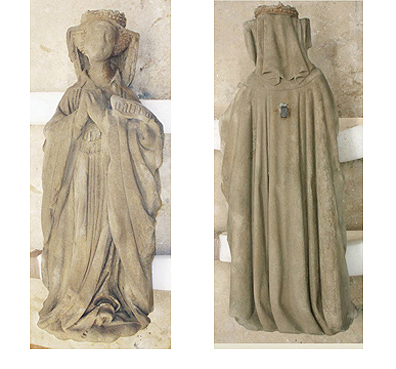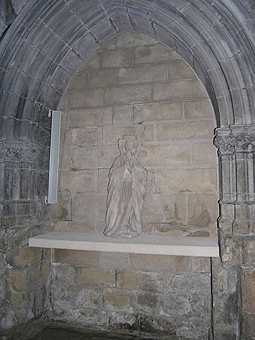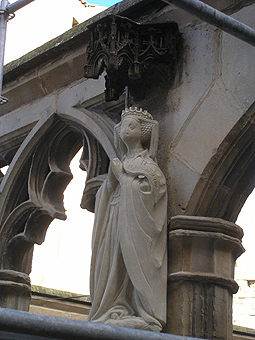The piece of the month of January 2010
PORTRAIT OF THE QUEEN DOÑA BLANCA IN SANTA MARÍA LA REAL DE OLITE
Mercedes Jover Hernando
Chair de Patrimonio y Arte Navarro
In the 15th century the court of the Kingdom of Navarre had in the Palace of Olite one of its main and most sumptuous residences. With Queen Doña Blanca (1358-1441) daughter of Carlos III the Noble and Leonor de Trastámara and mother of the Prince of Viana, Olite continued to be an important royal seat. Her first marriage to Martin of Sicily took her to those Mediterranean lands where she is still held in high esteem report, as a sensitive woman and as a modern legislator. After being widowed in 1409, she returned to Olite in 1415, establishing her home in this place residency program and marrying the prince Don Juan de Aragón in 1420. Death surprised him in Castilian lands, on the occasion of the marriage of his daughter Blanca. His health was delicate, and his death provoked struggles for the succession in the old Kingdom, for which his reign meant a moment of austerity.
Her relationship with Olite has been immortalized in the only known sculpture of this queen, whose portrait, as a regal and devout figure, has presided over the access to the cloister that precedes the church of Santa María de Olite, which she herself financed, until 2006.

Front and back image of Dª Blanca after her treatment.
This effigy of Queen Doña Blanca de Navarra sample shows us a lady sumptuously dressed in the French fashion of the time, with embroidered brial and wide cloak, garments that fall in thick folds, highlighting her headdress of horns (the hair in an updo that forms two lateral points on which the veil falls) on which the crown is raised, in which remains of the original gilding and polychrome can still be seen; rich necklaces complete the attire. Time has erased from the face the fleshy cheeks and the small lips that outlined the smile with which the sculptor of Burgundian origin, Johan Lome de Tournai, presumably portrayed her. Doña Blanca appears praying, standing, with joined hands and holding a phylactery with the registration MATER MEU DE. She is standing on a pedestal with her coat of arms (divided shield, 1 quartered of Navarre and Evreux; 2 quartered in crosses of Aragon, Castile and Leon) holding a greyhound on chestnut leaves and making a pair with the Virgin and Child, to whom she directs her prayer.
This delicate image carved in Gothic style in plenary session of the Executive Council XV century, around 1432, has suffered for decades the atmospheric rigor of the weather, which had weakened the sandstone that constitutes its support (105 x x cm). For this reason the department of Culture and Tourism-Principe de Viana Institution removed it in 2006 to apply a conservation and restoration treatment to stop the deterioration, consolidate the support, remove the accumulated dirt (black crust of contamination, added mortars and cements, mosses and biological attack), improve its impoverished appearance and guarantee its conservation.

Detail of the headdress with remains of the original polychrome.
The dismantling of the carving so that the treatment could be applied revealed a fine round sculpture that preserved, although minimal, some remains of the gilding and polychrome with which it was finished. The pictorial finish of the monumental sculpture was something not only frequent but almost obligatory at the time. These small remains are evidence of this and remind us of it.
Once the specialized conservation and restoration treatment was completed, the royal portrait was temporarily exhibited in the Palace of Olite itself, so that it could be admired in its entirety.

Original of the image inside the temple

Replica of the image in its place of origin
Its delicate state of conservation, its iconographic importance (there are not so many royal portraits of the period that are preserved) and artistic (it is a work attributed to the artist of the court of the Evreux, Johan Lome de Tournai) made those responsible for the cultural heritage of Navarre, with the help of approval of the parish and the Diocese, owners of the property, have made a replica of the image, which has been on display in situ since December 30, 2009, while the original is kept under an arcosolium adapted for the purpose, inside the church of Santa María la Real de Olite, at receipt from water, wind and sudden changes in temperature and humidity, which would undermine the integrity of this important Gothic carving.
bibliography
Steven Janke, R., Jehan Lome y la escultura gótica posterior en Navarra, Pamplona, Diputación Foral de Navarra, 1977, pp. 173-176.
García Gaínza et al, Catalog Monumental de Navarra III. Merindad de Olite, Pamplona, Government of Navarra, 1985, pp. 283-284.
Martínez de Aguirre Aldaz, J., Arte y Monarquía en Navarra 1328-1425, Pamplona, Government of Navarra, 1987, pp. 324-325.
Ramírez Vaquero, E., Historia de Navarra II. La leave Edad average, Pamplona, Gobierno de Navarra, 1993, p. 41.
Martínez de Aguirre, J., and Menéndez-Pidal, F., Emblemas heráldicos en el arte medieval navarro, Pamplona, Government of Navarra, 1996, p. 217.
